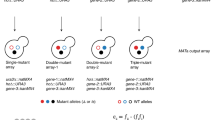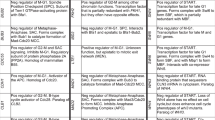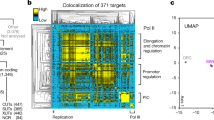Abstract
Defining the functional relationships between proteins is critical for understanding virtually all aspects of cell biology. Large-scale identification of protein complexes has provided one important step towards this goal; however, even knowledge of the stoichiometry, affinity and lifetime of every protein–protein interaction would not reveal the functional relationships between and within such complexes. Genetic interactions can provide functional information that is largely invisible to protein–protein interaction data sets. Here we present an epistatic miniarray profile (E-MAP)1 consisting of quantitative pairwise measurements of the genetic interactions between 743 Saccharomyces cerevisiae genes involved in various aspects of chromosome biology (including DNA replication/repair, chromatid segregation and transcriptional regulation). This E-MAP reveals that physical interactions fall into two well-represented classes distinguished by whether or not the individual proteins act coherently to carry out a common function. Thus, genetic interaction data make it possible to dissect functionally multi-protein complexes, including Mediator, and to organize distinct protein complexes into pathways. In one pathway defined here, we show that Rtt109 is the founding member of a novel class of histone acetyltransferases responsible for Asf1-dependent acetylation of histone H3 on lysine 56. This modification, in turn, enables a ubiquitin ligase complex containing the cullin Rtt101 to ensure genomic integrity during DNA replication.
This is a preview of subscription content, access via your institution
Access options
Subscribe to this journal
Receive 51 print issues and online access
$199.00 per year
only $3.90 per issue
Buy this article
- Purchase on SpringerLink
- Instant access to full article PDF
Prices may be subject to local taxes which are calculated during checkout




Similar content being viewed by others
References
Schuldiner, M. et al. Exploration of the function and organization of the yeast early secretory pathway through an epistatic miniarray profile. Cell 123, 507–519 (2005)
Tong, A. H. et al. Global mapping of the yeast genetic interaction network. Science 303, 808–813 (2004)
Pan, X. et al. A DNA integrity network in the yeast Saccharomyces cerevisiae. Cell 124, 1069–1081 (2006)
Kelley, R. & Ideker, T. Systematic interpretation of genetic interactions using protein networks. Nature Biotechnol. 23, 561–566 (2005)
Ye, P. et al. Gene function prediction from congruent synthetic lethal interactions in yeast. Mol. Syst. Biol. 1, 2005.0026 (2005)
Collins, S. R., Schuldiner, M., Krogan, N. J. & Weissman, J. S. A strategy for extracting and analyzing large-scale quantitative epistatic interaction data. Genome Biol. 7, R63 (2006)
Gavin, A. C. et al. Proteome survey reveals modularity of the yeast cell machinery. Nature 440, 631–636 (2006)
Krogan, N. J. et al. Global landscape of protein complexes in the yeast Saccharomyces cerevisiae. Nature 440, 637–643 (2006)
Collins, S. R. et al. Towards a comprehensive atlas of the physical interactome of Saccharomyces cerevisiae. Mol. Cell. Proteomics doi: 10.1074/mcp.M600381-MCP200 (2 January 2007).
Hong, E. L. et al. Saccharomyces Genome Database 〈http://www.yeastgenome.org/〉 (7 March 2006).
Hastie, T., Tibshirani, R. & Friedman, J. The Elements of Statistical Learning: Data Mining, Inference, and Prediction (Springer, New York, 2001)
Kornberg, R. D. Mediator and the mechanism of transcriptional activation. Trends Biochem. Sci. 30, 235–239 (2005)
Bjorklund, S. & Gustafsson, C. M. The yeast Mediator complex and its regulation. Trends Biochem. Sci. 30, 240–244 (2005)
van de Peppel, J. et al. Mediator expression profiling epistasis reveals a signal transduction pathway with antagonistic submodules and highly specific downstream targets. Mol. Cell 19, 511–522 (2005)
Takagi, Y. et al. Head module control of mediator interactions. Mol. Cell 23, 355–364 (2006)
Michel, J. J., McCarville, J. F. & Xiong, Y. A role for Saccharomyces cerevisiae Cul8 ubiquitin ligase in proper anaphase progression. J. Biol. Chem. 278, 22828–22837 (2003)
Tyler, J. K. Chromatin assembly. Cooperation between histone chaperones and ATP-dependent nucleosome remodeling machines. Eur. J. Biochem. 269, 2268–2274 (2002)
Schwabish, M. A. & Struhl, K. Asf1 mediates histone eviction and deposition during elongation by RNA polymerase II. Mol. Cell 22, 415–422 (2006)
Recht, J. et al. Histone chaperone Asf1 is required for histone H3 lysine 56 acetylation, a modification associated with S phase in mitosis and meiosis. Proc. Natl Acad. Sci. USA 103, 6988–6993 (2006)
Masumoto, H., Hawke, D., Kobayashi, R. & Verreault, A. A role for cell-cycle-regulated histone H3 lysine 56 acetylation in the DNA damage response. Nature 436, 294–298 (2005)
Maas, N. L., Miller, K. M., DeFazio, L. G. & Toczyski, D. P. Cell cycle and checkpoint regulation of histone H3 K56 acetylation by Hst3 and Hst4. Mol. Cell 23, 109–119 (2006)
Celic, I. et al. The sirtuins Hst3 and Hst4p preserve genome integrity by controlling histone H3 lysine 56 deacetylation. Curr. Biol. 16, 1280–1289 (2006)
Schneider, J., Bajwa, P., Johnson, F. C., Bhaumik, S. R. & Shilatifard, A. Rtt109 is required for proper H3K56 acetylation: a chromatin mark associated with the elongating RNA polymerase II. J. Biol. Chem. 281, 37270–37274 (2006)
Ozdemir, A. et al. Characterization of lysine 56 of histone H3 as an acetylation site in Saccharomyces cerevisiae. J. Biol. Chem. 280, 25949–25952 (2005)
Adkins, M. W., Carson, J. J., English, C. M., Ramey, C. J. & Tyler, J. K. The histone chaperone anti-silencing function 1 stimulates the acetylation of newly synthesized histone H3 in S-phase. J. Biol. Chem. 282, 1334–1340 (2007)
English, C. M., Adkins, M. W., Carson, J. J., Churchill, M. E. & Tyler, J. K. Structural basis for the histone chaperone activity of Asf1. Cell 127, 495–508 (2006)
Luke, B. et al. The cullin Rtt101p promotes replication fork progression through damaged DNA and natural pause sites. Curr. Biol. 16, 786–792 (2006)
Davierwala, A. P. et al. The synthetic genetic interaction spectrum of essential genes. Nature Genet. 37, 1147–1152 (2005)
Schuldiner, M., Collins, S. R., Weissman, J. S. & Krogan, N. J. Quantitative genetic analysis in Saccharomyces cerevisiae using epistatic miniarray profiles (E-MAPs) and its application to chromatin functions. Methods 40, 344–352 (2006)
Mizzen, C. A., Brownell, J. E., Cook, R. G. & Allis, C. D. Histone acetyltransferases: preparation of substrates and assay procedures. Methods Enzymol. 304, 675–696 (1999)
Acknowledgements
We are grateful to K. Tipton and M. Bassik for critically reading the manuscript, S. Gasser, B. Frey and Vincent Cheung for discussion, and G. Narlikar for reagents. We thank N. Datta, T. Punna, N. Thompson, M. Ballantine, N. Gabovic, A. Wind, K. Chin, Y. Xue, A. Chan, Y. Xue, T. Chan, M. Xan, M. Lim, H. Dalgleish, K. Vachon, L. Le, C. Sun, Z. Hassam, J. Rilestone and K. Takhar for technical assistance. We also thank S. Jackson, Z. Zhang, Vanessa Cheung, F. Winston, J. Erkmann and P. Kaufman for communicating results before publication. This research was supported by grants from Genome Canada and the Ontario Genomics Institute (J.F.G., A.E., C.B. and B.A.), the NIH (D.P.T.), the Howard Hughes Medical Institute (J.S.W.) and the Canadian Institute of Health Research (N.J.K., C.J.I. and G.W.B.). S.R.C. was funded by a fellowship from the Burroughs Wellcome Fund. N.J.K. is a Sandler Family Fellow.
Author information
Authors and Affiliations
Corresponding authors
Ethics declarations
Competing interests
Reprints and permissions information is available at www.nature.com/reprints. The authors declare no competing financial interests.
Supplementary information
Supplementary Information
This file contains Supplementary Methods, Supplementary Discussion, Supplementary Figures 1-3 with legends and additional references. (PDF 10810 kb)
Supplementary Zip 1
Summary of mutations and genetic profiles.xls” contains a list of all the mutations used in the study, as well as a functional annotation for the corresponding gene, and a list of other mutations with a similar profile of interactions. Summary of genetic data for phys int.doc” contains a summary of genetic interaction data for all pairs of physically interacting proteins analyzed in this study. Chromosome biology EMAP data.txt” contains all of the genetic interaction scores from this study in a tab-delimited form. Chromosome biology genetic interaction scores.xls” contains all of the genetic interaction scores from this study in an Excel format. Chromosome biology correlations.xls” contains all of the pairwise correlations between the genetic interaction profiles created in this study. Chromosome biology COP.xls” contains a COP score computed for every pair of mutations in this study. Clusters” is a folder containing hierarchical clustering of the genetic interaction and COP data. These clusters can be viewed using the Java Treeview program. Instructions for downloading and installing Java Treeview and for viewing the clusters are included in the Clusters folder. (ZIP 17541 kb)
Supplementary Zip 2
This archive contains a folder structure containing (text) data files which include all of the colony size measurements used in this study. This file also contains a summary text file explaining the contents. (ZIP 18374 kb)
Rights and permissions
About this article
Cite this article
Collins, S., Miller, K., Maas, N. et al. Functional dissection of protein complexes involved in yeast chromosome biology using a genetic interaction map. Nature 446, 806–810 (2007). https://doi.org/10.1038/nature05649
Received:
Accepted:
Published:
Issue Date:
DOI: https://doi.org/10.1038/nature05649



